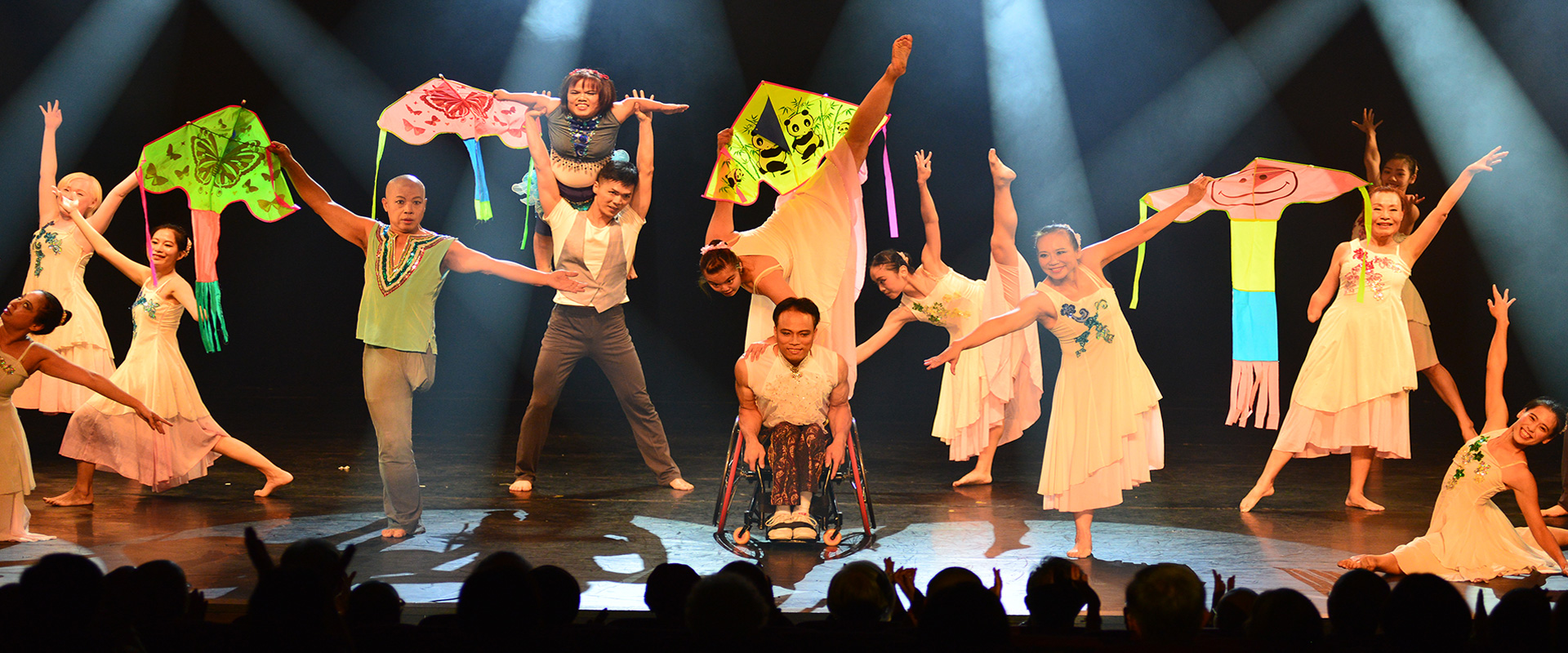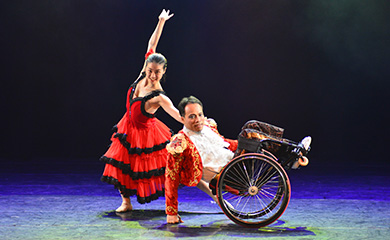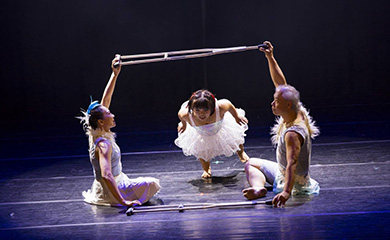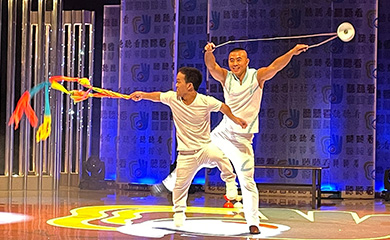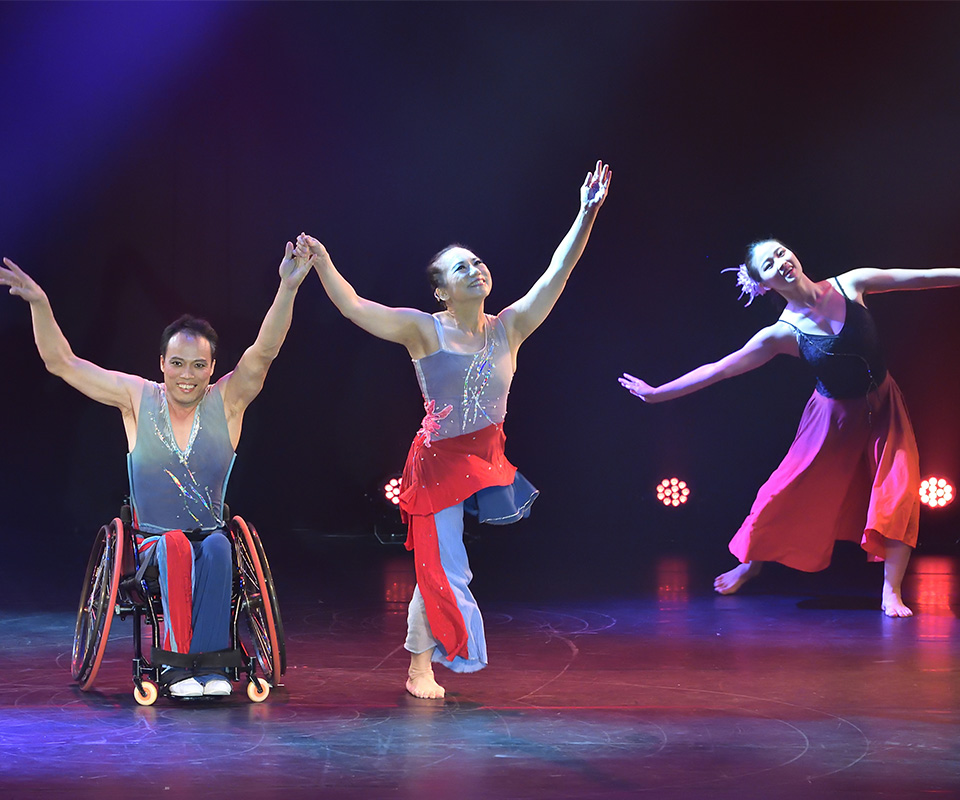Partially Sighted and photophobia, still facing towards the light
The “Bird and Water Dance Ensemble” dancers come from all dark corners, but are brave enough to step out of the darkness and move forward towards the light. While music was playing, two dancers who fear the light started dancing. They were both covered by the curtain. In their journey to find the light, they moved up and down, left and right struggling to move forward and remained deeply trapped, they collided. The silhouette of a struggling figure, a silent cry, letting go of the curtain in their hands is the only way to catch a breath, is the road they have been searching for so long, their own light.
Li Yi-Hui, who suffers from amblyopia in both eyes due to a congenital macular degeneration, was initially misdiagnosed as a slow learning with a learning disorder and slow reaction. Tsai Yu-Chen´s congenital albinism was accompanied with amblyopia and photophobia. Her vision was only 0.1, making it hard for her to focus and turn around to position herself. Although their blurred vision makes them struggle, in the world of dance all peculiarities are turned into traits that help them find another way to interpret life.
-
In the silence, agile dance moves lead the beat
The eyes focus on every swirling moment while the body and the diabolo compose the melody of inner surging in the silent world. In order to break through the limitations of being the hearing impaired, he practiced at least four hours a day for 18 years making little progress every day. It is thanks to years of sweat and tears that he achieved to become the champion of fancy diabolo. When describing Ming-Wei, Yen said, “He pushes himself to become the best version of himself. If he misses a move, he will not just redo the last step, but will restart the choreography from the very beginning. Once finished, he will nod and smile.”
Chiang Ning, known as the “street dance obba” (a Korean term referring to an older brother), has a tiny body shape different from ordinary people. He was bullied by his classmates thus isolated himself from the world. More than 10 years ago, his passion for dancing was ignited by the Korean wave. Due to lack of awareness of congenital achondroplasia, his bones are relatively more fragile and he cannot run or jump like others. After 12 years of long-standing practice, deformation, inflammation, and compression made it impossible for him to stand for long periods of time. To continue enjoying the beauty of music and the audience’s applauses, he started paying closer attention to the changes in his body, understanding his limitations and accepting himself as a dancer. From dancing alone next to a river, to joining a dance troupe, he opened his heart to the group and developed his wings of confidence.
-
With a hurting body, but an enormous motivation
Hurting an ankle after falling, hitting the flag stand on the side stage, but continuing to perform after being wrapped up with layers of bandages. After stepping on nails, the next step is to shake your feet. A kick to the searchlight, blood will scatter through the spinning lamp. Accidentally falling from the stage, then jumping back swiftly to complete the dance steps. Quickly restoring balance and arriving at positioning after the limbs collided. Afraid of being kicked and beaten, they smartly jump away. Every performance is like a close physical fight.
“In fact, what you can see is nerve-wracking, and what you can’t see is invincible!”, said Yen with a smile. According to the scene’s flexibility, an understanding of the rhythmic tacit and skillful formation helps reduce injuries. The dancers lay out the complementary roles of protecting and being protected to provide the possibility of cross body dance. Through synergy of mutual support, the dancers interpreted different perceptions and achieved the ideal of visual fusion, turning all kinds of obstacles into nothing, like a jigsaw puzzle with its own characteristics, connecting the most beautiful mental images on stage.
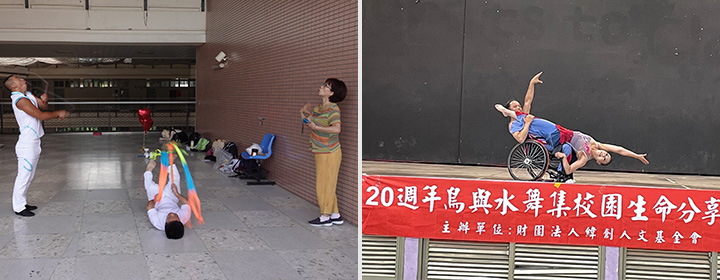
The head of the troupe, Mrs. Yen Tsui-Chen, (far right in the left photo), borrowed the school’s open space and lead the group to rehearse in the toughest way.
-
Lead a hard life to come across yourself in a different aspect
Apart from being dancers, most of the troupe members have their own social roles. Knowing that his dancing time is limited, Chiang-Ning continued to study and learned other skills. Chen Ming-Wei, who plays the diabolo, works as an administrator at a school, and is beloved by students and teachers for being “quick of eye and deft of hand”. What’s more, he uses the income from work and competitions or performances to support his family’s expenses and father’s medical expenses after a stroke. In addition to working as an aromatherapy lecturer and oil massage therapist, Li Yi-Hui is also a champion in both domestic and international sports, having won 11 consecutive national championships in sprinting and long jumping, and even used her legs to build and run a stable home for her family. The albino Tsai Yu-Chen relies on her concentration and memory. Tsai has climbed to the top of national rankings of the disabled business management category. As a college student, she is actively involved in charity activities. She is a strong believer that “amblyopia is not a synonym of underprivileged.”
-
Creating infinite possibilities of life
The name “Bird and Water” symbolizes Yen’s expectation for the members, hoping they will spread their wings, embrace the blue sky and ocean, accept their imperfections and fly to where their hearts desire. To not blame themselves nor give up when encountering difficulties. To take difficulties as challenges and gradually sculpt their hearts to embrace the blue sky like a bird and flow free like water. Every performance resembles the beauty of imagery. “It is the reflection of a tree branch in a stream, shining in it but not in it”. The audience experienced first-hand that the most profound and moving portion of the performance is the resilience and courage of dancers onstage. Their routine is a reflection of their souls, resonating the value of vitality and infinite possibilities.
To value what you have is to respect what you have lost. Yen said, “It’s not only about dancing. As long as we do what we love, focusing on doing it well, everyone can break the invisible shackles inside, and seek the truth, goodness, and beauty. Our heart has the power we need to achieve our dreams!”




 中
中
